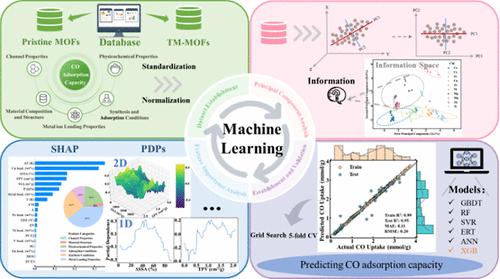金属-有机框架吸附剂CO吸附的集成学习优化设计
IF 4.7
2区 化学
Q1 CHEMISTRY, INORGANIC & NUCLEAR
引用次数: 0
摘要
金属有机骨架(MOFs)由于其大孔隙体积、多样的周期网络结构和可设计性而具有很大的吸附一氧化碳(CO)的潜力。机器学习有望为设计高效MOFs吸附剂提供优化参数,避免耗时的实验。在此,我们提出了一种考虑多维特征分析的集成学习策略,以合理设计mof的孔隙几何形状、结构性质和合成条件,从而实现高性能的CO吸附。极值梯度增强模型的预测效果最好(R2 >;0.95)在有限的数据集大小下。孔隙特征是原始mof的主要影响因素。预测结果表明,具有一维、二维、微孔和孤立孔的mof对CO的吸附效果最佳,总孔体积为0.4-0.6 cm3/g。这种增强的吸附能力可归因于分子扩散途径的缩短。结构参数的相对意义如下:空间群>;几何比;拓扑。最优结构构型包括R3m空间群、双核桨轮几何形状和蝎形拓扑结构。在过渡金属修饰的mof中,Cu(I)对CO的结合亲和力最强,而Fe(II)和Ni(II)可以作为有效的结合位点。该研究为设计高效吸附CO的吸附剂提供了理论指导。本文章由计算机程序翻译,如有差异,请以英文原文为准。

Ensemble-Learning-Guided Optimization Design for Metal–Organic Framework Adsorbents toward CO Adsorption
Metal–organic frameworks (MOFs) hold great potential for carbon monoxide (CO) adsorption owing to their large pore volume, diverse periodic network structures, and designability. Machine learning is anticipated to provide optimization parameters for designing high-efficiency MOFs adsorbents, avoiding time-consuming experiments. Here, we proposed an ensemble-learning strategy accounting for multidimensional analysis of features to rationally design pore geometries, structural properties, and synthesis conditions of MOFs toward high performance for CO adsorption. The extreme gradient boosting model exhibited the best predictive performance (R2 > 0.95) under limited data set size. Porous characteristic was identified as a dominant factor in pristine MOFs. Prediction results illustrated that MOFs featuring one-dimensional, two-dimensional, microporous, and isolated pores were optimal for CO adsorption, with 0.4–0.6 cm3/g total pore volume. This enhanced adsorption capacity can be attributed to the shortened molecular diffusion pathways. The relative significance of structural parameters followed: space groups > geometry > topology. The optimal structural configuration involved space group of R3m, binuclear paddle wheel geometry, and scorpionate-like topology. Regarding transition metal-modified MOFs, incorporated Cu(I) demonstrated the strongest binding affinity toward CO, while Fe(II) and Ni(II) could serve as effective binding sites. This work offers a theoretical guidance for designing efficient adsorbents toward CO adsorption.
求助全文
通过发布文献求助,成功后即可免费获取论文全文。
去求助
来源期刊

Inorganic Chemistry
化学-无机化学与核化学
CiteScore
7.60
自引率
13.00%
发文量
1960
审稿时长
1.9 months
期刊介绍:
Inorganic Chemistry publishes fundamental studies in all phases of inorganic chemistry. Coverage includes experimental and theoretical reports on quantitative studies of structure and thermodynamics, kinetics, mechanisms of inorganic reactions, bioinorganic chemistry, and relevant aspects of organometallic chemistry, solid-state phenomena, and chemical bonding theory. Emphasis is placed on the synthesis, structure, thermodynamics, reactivity, spectroscopy, and bonding properties of significant new and known compounds.
 求助内容:
求助内容: 应助结果提醒方式:
应助结果提醒方式:


